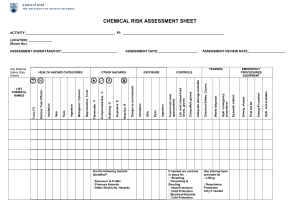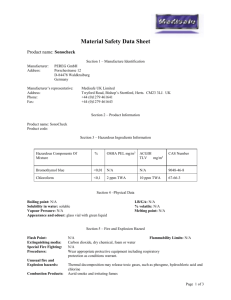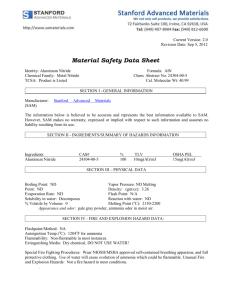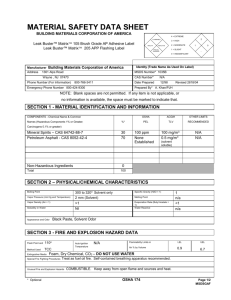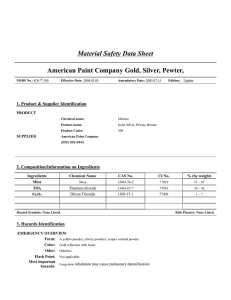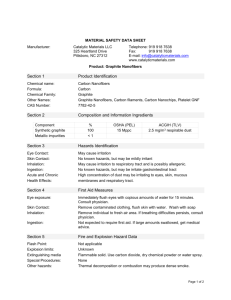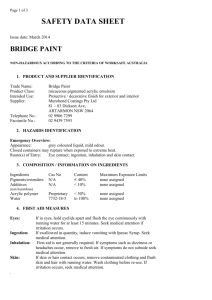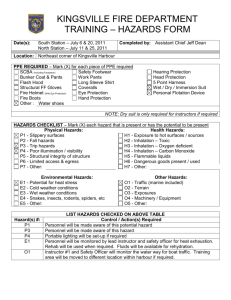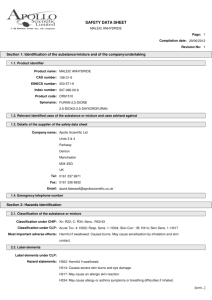INTER-OFFICE MEMO - Trafa Pharmaceutical Supplies
advertisement
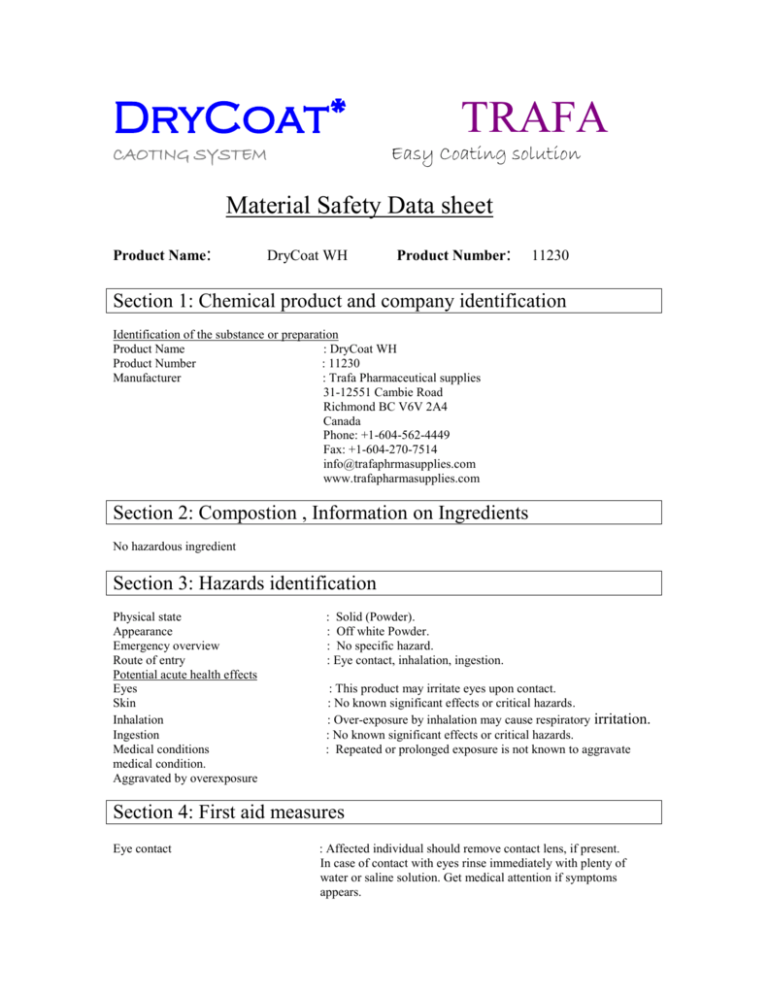
DryCoat* TRAFA Easy Coating solution CAOTING SYSTEM Material Safety Data sheet Product Name: DryCoat WH Product Number: 11230 Section 1: Chemical product and company identification Identification of the substance or preparation Product Name : DryCoat WH Product Number : 11230 Manufacturer : Trafa Pharmaceutical supplies 31-12551 Cambie Road Richmond BC V6V 2A4 Canada Phone: +1-604-562-4449 Fax: +1-604-270-7514 info@trafaphrmasupplies.com www.trafapharmasupplies.com Section 2: Compostion , Information on Ingredients No hazardous ingredient Section 3: Hazards identification Physical state Appearance Emergency overview Route of entry Potential acute health effects Eyes Skin Inhalation Ingestion Medical conditions medical condition. Aggravated by overexposure : Solid (Powder). : Off white Powder. : No specific hazard. : Eye contact, inhalation, ingestion. : This product may irritate eyes upon contact. : No known significant effects or critical hazards. : Over-exposure by inhalation may cause respiratory irritation. : No known significant effects or critical hazards. : Repeated or prolonged exposure is not known to aggravate Section 4: First aid measures Eye contact : Affected individual should remove contact lens, if present. In case of contact with eyes rinse immediately with plenty of water or saline solution. Get medical attention if symptoms appears. Skin Contact Inhalation Ingestion : Wash contaminated skin with soap and water. Get medical Medical attention if irritation develops. : If inhaled, remove to fresh air. Get medical attention if symptoms appears. If exposed person is not breathing , give artificial respiration or oxygen applied by trained personnel. : Do not induce vomiting unless directed to do so by medical personnel. Never Give anything by mouth to an un conscious person. Get medical attention if Symptoms appear. Section 5: Fire fighting measures Flammability of the product Product of Combustion : Non –Flammable : During combustion, product may emit but not limited to carbon dioxide, carbon monoxide. Fire fighting media and instructions : Use dry chemicals, CO2, water spray or foam. Use an extinguishing agent suitable for surrounding fires. Special protective equipment : Fire Fighters should wear appropriate protective equipment and Self-contained breathing apparatus (SCBA) with a full face piece operated in positive pressure mode. Special remarks on exposion hazards : Fine dust clouds may form explosive mixtures with air Section 6: Accidental release measures Personal precautions Environmental precautions Methods for cleaning up : keep unnecessary personnel away. Use Suitable protective equipment. : Avoid dispersal of spilled material and runoff and contact with soil , waterways ,drains and sewers. : If emergency personnel are unavailable vacuum or carefully scoop up spilled materials and place in an appropriate container for disposal. avoid creating dusty conditions and prevent wind dispersal. Section 7: Handling and storage Handling Storage : Avoid breathing dust. : keep container tightly closed. Keep container in a cool , well-ventilated area. Section 8: Exposure Controls, Personal Protection Engineering controls : Use process enclosures, local exhaust ventilation, or Other engineering controls to keep airborne levels below recommended exposure limits. Personal protection Eyes Skin : Safety eyewear complying with an approved standard should be used when a risk assessment indicates this is necessary to avoid exposure to liquid splashes , mists or dusts. : Personal protective equipment for the body should be selected based on the task being performed and the risks involved and should be approved by a specialist before handling this producer. Respiratory Hands Personal protection in case of a large spill : Use a properly fitted, particulate filter respiratory complying with an approved standard if a risk assessment indicates this is necessary. Respiratory selection must be based on known or anticipated exposure levels , the hazards of the product and the safe working limits of the selected respirator : Chemical –Resistant, impervious gloves or gauntlets complying with an approved breathing apparatus should be worn at all times when handling chemical products if a risk assessment indicates this is necessary. : splash goggles Full suit. Dust respirator. Boots .Gloves. A selfcontained breathing apparatus should be used to avoid inhalation of the product. Suggested protective clothing might not be sufficient: Consult a specialist Before handling this product. Section 9: Physical and Chemical properties Physical State and Appearance Melting/Freezing points : Solid (Powder) : >300 C based on cellulose Section 10: stability and reactivity Stability and reactivity Hazardous polymerization : The product is stable. : Will not occur Section 11: Toxicological information Toxic effects on Humans Carcinogenicity/Mutagenicity/ Reproductive toxicity : Slightly hazardous in case of eye contact (irritant), of Inhalation (lung irritant).Non-corrosive for skin. Non-irritant for skin. Non-sensitizer for skin.Non – permeator by skin. Non-hazardous in case of ingestion. None-sensitizer for lungs. Non-corrosive to eyes.NonCorrosive to lungs. : No known significant effects or critical hazards. Section 12: Ecological information Product of degradation Toxicity of the products of Biodegradation. : These products are carbon oxides (co, co2) and water. Some metallic oxides. : The product itself and its products of degradation are not toxic. Section 13: Disposal considerations Waste disposal : Waste must be disposed of in accordance with federal, state and local environmental control regulations. Consult your local or regional authorities Section 14: Transport information DOT Classification : Refer to the bill of lading for proper shipping information. Section 15: Regulatory information Canada WHMIS United States HCS Classification U.S. Federal regulations International regulations DSCL (EEC) : Not controlled under WHMIS (Canada) CEPA DSL: cellulose, carboxymethyl ether, sodium salt ; dextrins ; d-glucose; lecithins; 1,2,3-propanetricarboxylicAcid ; 2-hydroxy -,trisodium salt : Not regulated : TSCA 8 (b) cellulose, carboxymethyl ether, sodium salt ; dextrins ; d-glucose; lecithins; 1,2,3-propanetricarboxylicAcid ; 2-hydroxy -,trisodium salt : SARA 302/304/311/312 hazadous chemicals not applicable. Claen Water act (CWA) 311 and 307/Claen air act (CAA) 112. This product does not contain any ingredients requiring reporting under this section. : This product is not classified according to the EU regulations Section 16: Other information Hazardous Material information System (U.S.A) National Fire Protection Association (U.S.A) History Date of issue ; May 14 ,2007 Date of previous issue : no previous validation Version :1 Notice to reader To the best of our knowledge, the information contained herein is accurate. However, neither the above named supplier nor any of its subsidiaries assumes any liability whatsoever for the accuracy or completeness of the information contained herein. Final determination of suitability of any material is the sole responsibility of the user.All materials may present unknown hazards and shoul be used with caution.Although certain hazards are described herein , we cannot guarantee that these are the only hazards that exist.
